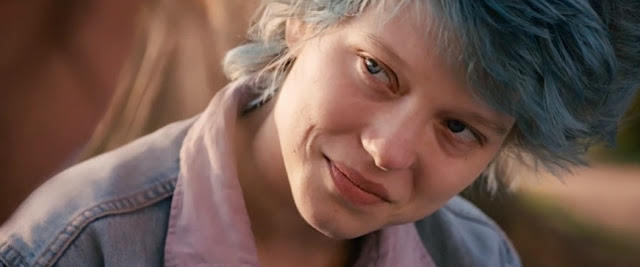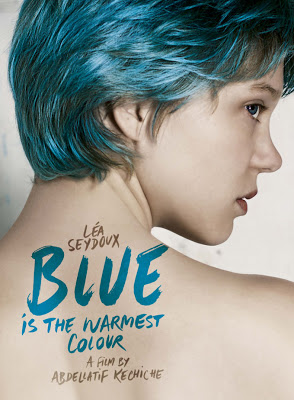Written by Rachel Redfern
 |
| Film poster for Blue is the Warmest Color |
Abdellatif Kechiche’s Blue is the Warmest Color is the first film with a lesbian protagonist to win the prestigious Palm D’or Award at the Cannes Film Festival. The French drama is based on Julie Maroh’s graphic novel and centers on the life of Adele, a fifteen year-old girl who becomes involved with another young woman. Remarkably, the film is three hours long, which doubles in length the normal hour and half for a romantic comedy in the US, a fact that must develop an enormously powerful love story.
The movie received high praise from critics, and both lead actresses, Adèle Exarchopoulos and Léa Seydoux, were given the Palme as a special prize due to their outstanding performances. Similarly, the film comes at a particularly important moment since France passed a bill allowing gay marriage only a few weeks ago, a bill that has been at the center of huge debates and massive rioting.
However, praise for the movie has been tempered by the controversy of its two graphic sex scenes that have a length on par with the film. While no one has clocked it yet, many have said that the scenes were at least ten minutes in length. This criticism has also been echoed by the writer of the graphic novel, Julie Maroh.
| Abdellatif Kechiche, Adèle Exarchopoulos and Léa Seydoux at the Cannes Film Festival |
It’s no secret that Maroh was disappointed in the two sex scenes, essentially calling them pornographic. It’s important to note that she wasn’t mad about the inclusion of sex scenes, but rather specifically called out the director on the lack of realism in the aforementioned scenes. In fact, as is the intention of pornography, she felt that the two scenes served no other purpose than to essentially live out a male director’s fantasies.
According to a statement written by Maroh in regard to fact that the audience was giggling during the scenes,
“The heteronormative laughed because they don’t understand it and find the scene ridiculous. The gay and queer people laughed because it’s not convincing, and found it ridiculous. And among the only people we didn’t hear giggling were the potential guys too busy feasting their eyes on an incarnation of their fantasies on screen.”
It’s not hard to sense Maroh’s pain here and with good reason since her reasons for writing Blue is the Warmest Color was to, “catch the attention of those who had no clue, who had the wrong picture based on false ideas.” Considering that Maroh intended to offer a more realistic portrayal of lesbian relationships and that instead she felt her goal had been reduced to the very unrealistic portrayal of lesbian pornographic sex, it’s easy to see why she would be upset.
This leads to some interesting questions about the nature of sex, specifically sex between women, in film. For instance, if the director had been female would the outcome have been different? Maroh believes that Kechiche was utilizing a very popular male gaze in the filming of those scenes; perhaps if the director had been a woman the scenes would have been different? However, if we follow that logic it would seem then that lesbian sex in art can only be created by other women?
 |
| Adèle Exarchopoulos and Léa Seydoux in Blue is the Warmest Color |
Women sleeping with women constitutes a massive portion of the pornographic film industry; there’s been an almost mythic build-up around the erotic nature of two women having sex. In that case, is there anyway to have non-pornographic lesbian sex scenes? Or is it meant only for the male gaze? (I say male gaze here only because it seems more suitable. While many women would also find it erotic, Maroh felt that it was catering to a very male sexual fantasy.)
Also, it should be noted that not every critic agrees that the scenes were pornographic. Richard Porton on The Daily Beast asks a fair question: “Should men—or for that matter women—aroused by these scenes be moralistically dissed as the arthouse equivalents of the raincoat brigade?” The film is a coming of age story, specifically a story of sexual awakening for a young girl. Sex, is by it’s nature erotic; any movie or novel that attempts to really portray the intensity of vibrant sexuality has to be, well…sexy.
Consider one of my favorite movies, Turn Me On Dammit, which portrays the heterosexual sexual awakening of a young girl but also features a scene where the main character fantasizes about one of her female friends. It’s showing a fantasy; therefore, it is titillating—although a bit silly. Perhaps it was the layer of humor then that kept those scenes from the same controversy and scrutiny as Blue is the Warmest Color? (Well, that and the fact that the scene is only about forty seconds long as opposed to a full ten minutes.)
What about heterosexual sex scenes? Is it possible to have non-pornographic heterosexual sex scenes? I would argue yes, Rules of Attraction, Melancholia, and hundreds of other films have done it. But has it been done with two women having sex? I have to say it’s hard for me to think of any.
However, should we not consider that as we continue to espouse the ideals of a more open and tolerant society—one in which sexuality in many forms is considered appropriate—that we will not agree with the portrayal of every sex scene? Could it also be argued that the director was merely displaying sex in a way that he found beautiful and fascinating?
To be fair, Maroh did differentiate between her perception of the film as a writer, where she understood the sex scenes to be another part of Kechiche’s vision, and her perception as a lesbian in which she felt it was inappropriate. But isn’t that the beauty and purpose of art? To showcase life from a variety of perspectives?
What do you think? Are there lesbian sex scenes that are not pornographic?
I’m sorry to only focus on the most tabloidy feature of an obviously powerful movie, but as it hasn’t been released yet, I’m afraid that I can comment little on the rest of the movie. Also, as stories about homosexuality become more and more a part of film, the hypersexualization of lesbian sex is something that needs to be addressed. Also, perhaps my own judgment of the scenes will be different after actually viewing them.

I’m not a lesbian and I haven’t seen the film, but the discussion reminds me of what someone once wrote about dialogue–that it should be better than real-life speech. Real-life speech is full of “uhs” and “ums,” mangled grammar and unfinished thoughts. And also, usually incredibly dull. Now you can drop an “um” every once in a while into movie or prose dialogue to make it “feel” real, but in the vast majority of cases, dialogue as it really happens would quickly become unreadable or unwatchable.
And isn’t this the case with sex as well? (Sure, there’s the so-called “amateur” sex industry, but I suspect that very little of that captures very average people having very average sex.) For me, the goal in art should be “truth” rather than “realism,” which can be two very different things. But I would love to read some comments from people who think we should demand “realism” in sex scenes when we don’t make the same demands of other aspects of movies, like dialogue.
Interesting thought, I never thought about it that way, but I think it’s a great point. Movies were originally designed to be escapist entertainment. People turn to the movies for home and adventure when their own lives seem difficult and hard.
So underneath that then, are we looking for a bit of fantasy in our art rather than strait up realism?
Well I think that’s often the case, yes. But I’m not sure it’s necessarily only about fantasy or wish-fulfillment. We do want to see ourselves in entertainment, or at least think we’re seeing ourselves. Perhaps the reaction by Maroh and others to the scenes in Blue is similar to the reactions others have when so many major studio movies take place in upper-middle class neighborhoods. Where are the normal people? But it’s worth remembering, I think, that even the “normal” people in entertainments are simulacra–representations of the real, not the real themselves. Even in the most “realistic” books and movies, we’re spared much of the tedium of the everyday, like going to the bathroom, flossing our teeth, hours of boredom, etc. That’s why I question why we would hold depictions sex to any higher standard than we do, say, dialogue. But I’d have to see the movie to really comment on these specific scenes.